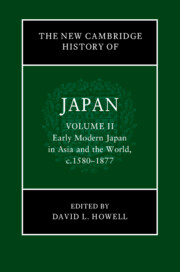Book contents
- The New Cambridge History of Japan
- The New Cambridge History of Japan
- The New Cambridge History of Japan
- Copyright page
- Contents
- Figures
- Maps
- Tables
- Contributors to Volume II
- Preface
- Frontispiece
- Introduction
- Part I The Character of the Early Modern State
- PART II Economy, Environment, and Technology
- 7 International Economy and Japan at the Dawn of the Early Modern Era
- 8 The Tokugawa Economy
- 9 The Pacific Context of Japan’s Environmental History
- 10 Scientific Communities and the Emergence of Science in Early Modern Japan
- 11 The Problem of Western Knowledge in Late Tokugawa Japan
- 12 Technology, Military Reform, and Warfare in the Tokugawa-Meiji Transition
- Part III Social Practices and Cultures of Early Modern Japan
- Index
- References
12 - Technology, Military Reform, and Warfare in the Tokugawa-Meiji Transition
from PART II - Economy, Environment, and Technology
Published online by Cambridge University Press: 15 January 2024
- The New Cambridge History of Japan
- The New Cambridge History of Japan
- The New Cambridge History of Japan
- Copyright page
- Contents
- Figures
- Maps
- Tables
- Contributors to Volume II
- Preface
- Frontispiece
- Introduction
- Part I The Character of the Early Modern State
- PART II Economy, Environment, and Technology
- 7 International Economy and Japan at the Dawn of the Early Modern Era
- 8 The Tokugawa Economy
- 9 The Pacific Context of Japan’s Environmental History
- 10 Scientific Communities and the Emergence of Science in Early Modern Japan
- 11 The Problem of Western Knowledge in Late Tokugawa Japan
- 12 Technology, Military Reform, and Warfare in the Tokugawa-Meiji Transition
- Part III Social Practices and Cultures of Early Modern Japan
- Index
- References
Summary
The collapse of the Tokugawa shogunate and the subsequent rise of the Meiji government were accompanied by the Japanese archipelago’s first large-scale conflict in two centuries. Warfare was not merely a consequence of the social and political upheaval of the restoration era. Rather, organizational reforms and the adoption of new technologies helped accelerate the collapse of the shogunate and shaped the manner of the modern state’s consolidation. Rather than recounting campaigns and battles, this chapter focuses on three interlocking sets of themes: technology, social change, and gender. Each theme relates to a particular story of the restoration era: the replacement of traditional Japanese arms by gunpowder weapons; the decline of the samurai and the rise of the conscript soldier; and the effacement of warrior masculinity by the ideal of the patriotically subservient “serviceman” (gunjin).
Keywords
- Type
- Chapter
- Information
- The New Cambridge History of Japan , pp. 397 - 440Publisher: Cambridge University PressPrint publication year: 2023



